You might find it intriguing that the Emu War of 1932 coincided with the Great Depression, a time when Australian farmers were already struggling to make ends meet. As emus began to ravage wheat crops, the Australian government deployed soldiers armed with machine guns to control the population. But what was expected to be a swift and decisive victory turned into a debacle. The emus' speed and agility left the soldiers stunned, and despite expending considerable ammunition, they couldn't seem to make a dent in the emu population. But what really went wrong?
Key Takeaways
- In 1932, approximately 20,000 emus migrated to inland Western Australia, consuming significant wheat crops and damaging fences, amidst the Great Depression.
- The Australian military deployed armed personnel with machine guns, firing around 25,000 rounds, but killed only about 300 emus due to their speed and agility.
- The Emu War demonstrated the futility of using force against wildlife populations and raised ethical concerns about military intervention in wildlife control.
- The conflict highlighted the complexities of human-wildlife interactions and the need for humane and sustainable wildlife management practices.
Causes of the Emu War

You might wonder what triggered the Emu War, but it's actually quite straightforward: a massive migration of around 20,000 emus from coastal to inland Western Australia in 1932 sparked the conflict by causing significant damage to crops.
As you can imagine, farmers were already struggling due to the Great Depression, with falling wheat prices and no government subsidies to rely on.
The emus' arrival made things worse, as they consumed substantial amounts of wheat crops and damaged fences, allowing rabbits to further devastate agricultural lands.
Desperate farmers sought military intervention to control the growing emu threat, highlighting the tensions between agricultural interests and wildlife management.
The government's decision to deploy the military reflected the challenges of balancing human needs with nature.
Military Operations Against Emus
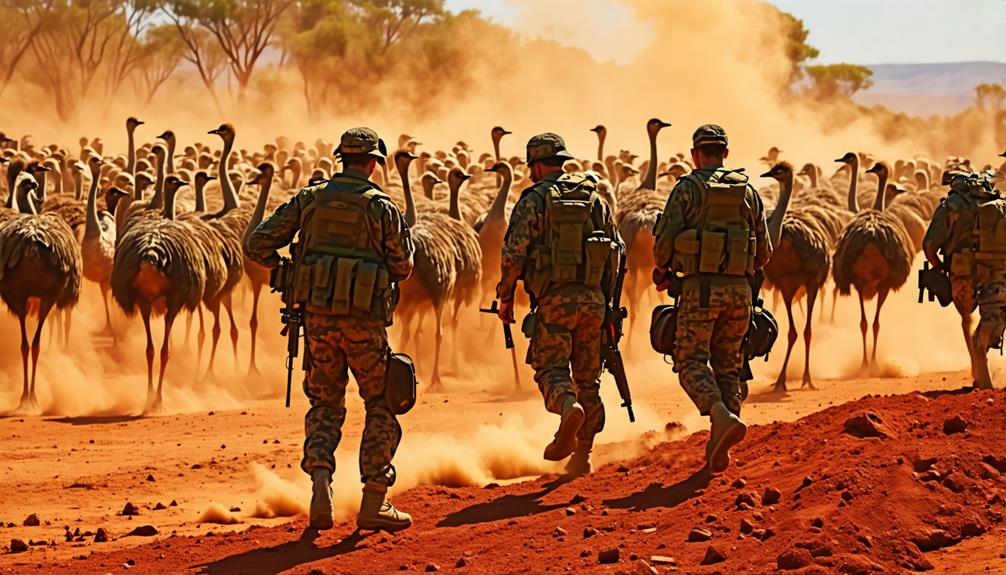
The Australian military's efforts to quell the emu threat began on November 2, 1932, with soldiers armed with machine guns and a hefty arsenal of 10,000 rounds of ammunition. You're part of Major Meredith's operation, tasked with taking down the emu population that's been ravaging crops.
However, initial attempts are ineffective – by November 8, 1932, you've fired 2,500 rounds, but only a small number of emus are killed. The soldiers face significant challenges due to the emus' speed and agility.
As the operation continues, approximately 25,000 rounds are expended, resulting in only around 300 emus killed. The military's efforts are proving to be minimal in controlling the population, and it's clear that these flightless birds are a formidable foe.
Human Conflict With Wildlife
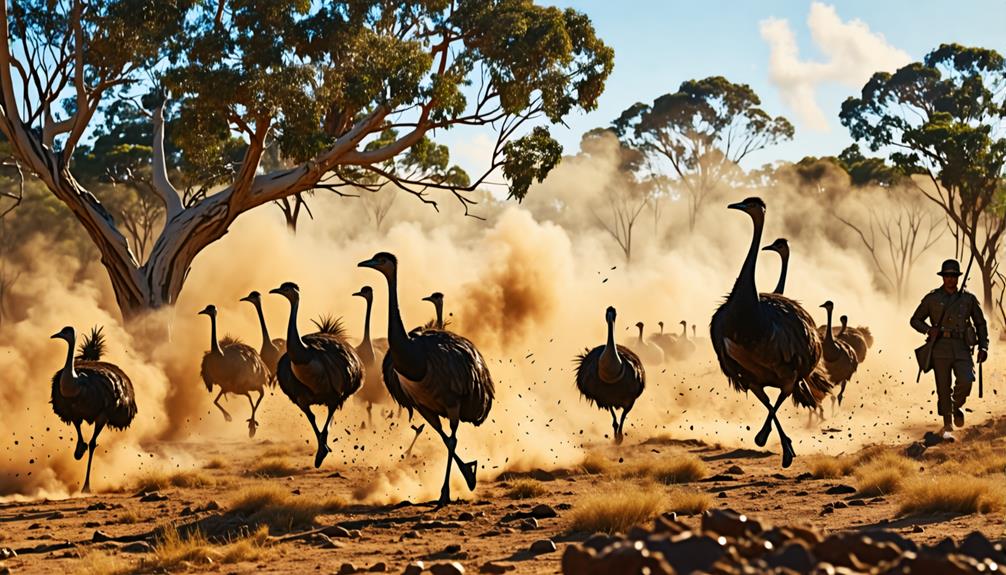
You're probably wondering what led to such a debacle in the Australian outback.
When humans clash with wildlife, you face complex challenges, including managing animal populations and mitigating the impact of human activities on habitats.
As you explore the lessons from the Emu War, you'll discover why sustainable conservation efforts are essential in preventing similar conflicts and preserving ecosystems.
Wildlife Management Challenges
Managing wildlife effectively poses significant challenges, particularly when human activities such as agriculture overlap with animal habitats, as seen in the 1932 Great Emu War.
You're faced with the dilemma of balancing economic interests with conservation needs.
The Australian military's involvement in the Emu War exemplifies the difficulties of wildlife management. Despite deploying machine guns, they struggled to control the emu population, suffering a notable defeat.
The emus' guerrilla tactics outsmarted the soldiers, raising ethical questions about using military force for wildlife control.
This debacle prompted a shift towards more humane wildlife management practices, emphasizing the need for collaborative approaches that respect both agricultural needs and ecological balance.
Effective strategies require considering the well-being of both humans and animals, finding a delicate balance.
Human Impact on Habitats
As wildlife management challenges like the Emu War demonstrate, human activities such as agricultural development can greatly encroach on animal habitats, sparking conflict between humans and wildlife.
You can see this clearly in the Great Emu War, where the conversion of land for wheat farming led to the overpopulation of emus in Western Australia.
The emus then caused significant crop damage, with farmers reporting losses of up to 20% of their wheat crops.
The conflict highlights the consequences of inadequate government support for farmers and the complexities of human-wildlife interactions.
It also underscores the need for sustainable wildlife management practices that consider both agricultural needs and the preservation of natural habitats.
Conservation Efforts Needed
One key takeaway from the Great Emu War is that human conflict with wildlife often necessitates long-term conservation efforts that prioritize the protection of natural habitats and the preservation of native species. As you consider the broader implications of this clash, you realize the importance of wildlife management that emphasizes humane treatment and sustainable coexistence. The following table highlights key aspects of conservation efforts needed to mitigate human-wildlife conflicts:
| Strategy | Description |
|---|---|
| Exclusion Barrier Fencing | Physical barriers to deter wildlife from agricultural areas |
| Non-Lethal Methods | Humane approaches to wildlife control, minimizing harm to animals |
| Public Awareness | Educating the public on the importance of wildlife conservation |
| Community Engagement | Collaborating with local communities to develop effective conservation plans |
| Habitat Preservation | Protecting and restoring natural habitats to support native species |
Failure of Military Methods

Australia's initial attempts to quash the emu uprising through force faltered spectacularly as the birds' impressive agility and speed allowed them to outmaneuver military personnel at every turn. In the Great Emu War, you see the Australian Army deploying machine guns, but these military methods prove ineffective in combat. Soldiers struggled to coordinate their efforts against the fast-moving targets, leading to a crushing defeat.
Approximately 25,000 rounds were fired, but only around 300 emus were killed, highlighting the ineffectiveness of the military's approach.
Machine guns frequently jammed, and mounting them on vehicles proved impractical.
The terrain hindered military operations, giving the emus an upper hand.
Despite firing over 10,000 rounds in a second offensive, the emu population remained largely unaffected, underscoring the futility of the military's efforts.
Emus Outsmart the Military

While the Australian military was well-equipped with machine guns and tactical planning, the emus proved to be a formidable opponent, consistently outsmarting and evading their attempts to capture or kill them. You see, these flightless birds displayed remarkable agility and intelligence, making them difficult targets for the soldiers. With their ability to run at speeds of up to 30 miles per hour, as noted by Major G. P. W. Meredith, the emus could easily outrun the military's tactics.
| Emu Characteristics | Military Tactics | Outcome |
|---|---|---|
| Agility | Machine guns | Few emus killed |
| Intelligence | Tactical planning | Emus outsmarted military |
| Speed (up to 30 mph) | Vehicle-mounted guns | Mobility issues |
| Adaptability | Disorganized pursuits | Emus evaded capture |
| Physical prowess | Wounded emus still ran | Military failure |
Aftermath of the Disaster
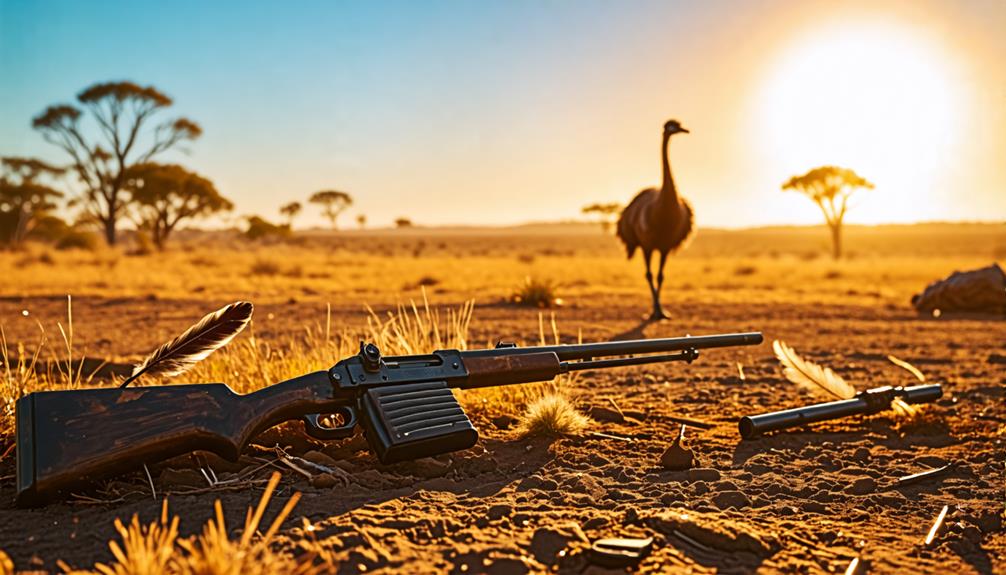
The Australian military's debacle in the Great Emu War ultimately had far-reaching consequences, leading to significant changes in the country's approach to wildlife management.
You see, the Australian government was forced to reevaluate its methods after the military's failure to control the emu population.
Here are some key outcomes:
- The government started implementing exclusion barrier fencing to protect crops from wildlife, a more effective and humane approach.
- The military's defeat led to public ridicule, which in turn raised awareness about the need for ethical treatment of animals and conservation.
- Farmers continued to struggle with emus, but their requests for military assistance were denied.
Lessons Learned From Nature
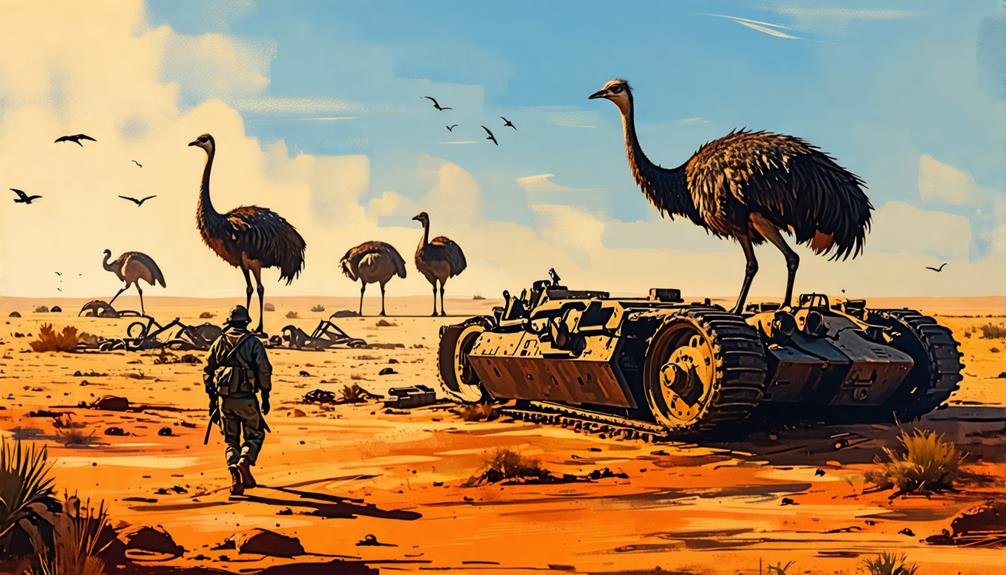
You're about to discover the valuable lessons the Emu War taught us about respecting nature's boundaries and living in harmony with wildlife.
As you explore these key takeaways, you'll realize that understanding animal behavior and ecology is essential for developing effective conservation strategies.
Respect Nature's Boundaries
In the aftermath of the Great Emu War, Australia learned a valuable lesson about respecting nature's boundaries: that imposing human will on wildlife through force is often a recipe for disaster.
You see, the military's efforts to cull the emu population not only failed but also highlighted the limits of human control over nature. It's a humbling experience that teaches you the importance of humility in wildlife management.
Some key takeaways from this ordeal include:
- Military intervention is rarely an effective solution in wildlife conflicts
- Understanding animal behavior is vital in conservation efforts
- Human control over nature has its limits
These lessons serve as a reminder that respecting nature's boundaries is key to avoiding such humiliating defeats.
Harmony With Wildlife
Building on the lessons of respecting nature's boundaries, learning to live in harmony with wildlife requires embracing a more nuanced understanding of the natural world and our place within it.
As the Great Emu War demonstrated, traditional wildlife management tactics often prove ineffective, highlighting the need for non-lethal approaches like habitat management and exclusion fencing.
You must adopt humane strategies that prioritize ecological balance and collaboration with local communities. Conservationists advocate for these methods, seeking to protect native wildlife and promote agricultural harmony.
By recognizing the importance of coexistence, you can work towards a more sustainable future, one where wildlife and humans thrive together.
Embracing this mindset allows you to navigate the complex relationships between species, ensuring a more harmonious relationship with the natural world.
Legacy of Defeat and Humor
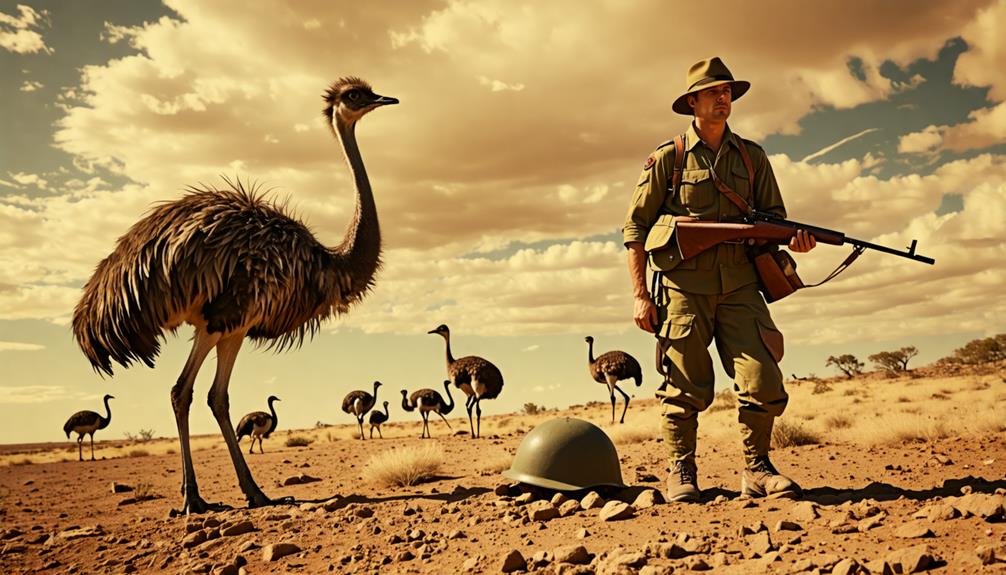
Australia's humiliating defeat at the hands of the emus has morphed into a beloved cultural phenomenon, with the debacle frequently poked fun at in jokes, memes, and satire that showcases the nation's ability to laugh at itself.
You can't help but chuckle at the absurdity of the Emu War, where the Australian military's failure to manage wildlife has become a timeless source of humor. The public reaction was merciless, mocking the military's efforts and cementing the event's legacy as a cultural touchstone.
Some key aspects of the Emu War's legacy include:
- Widespread ridicule of the military's failed intervention
- Artistic interpretations, such as musicals and films, that poke fun at the event
- The Emu War's enduring presence in Australian humor and satire
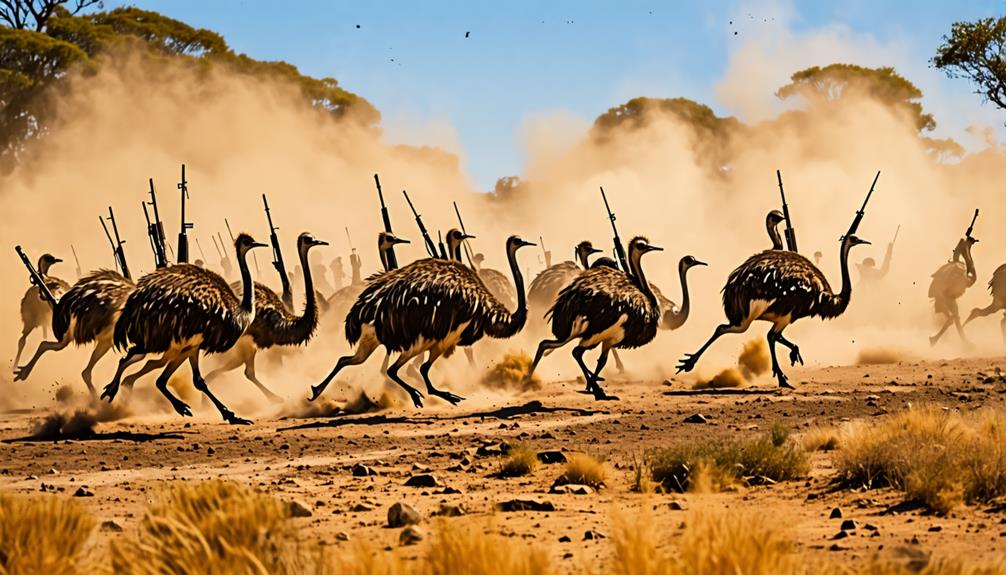
Leave a Reply